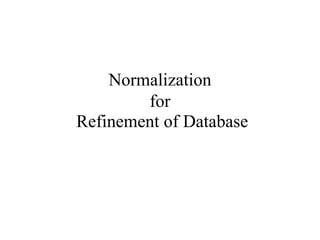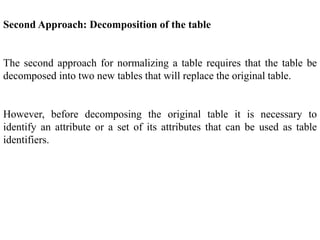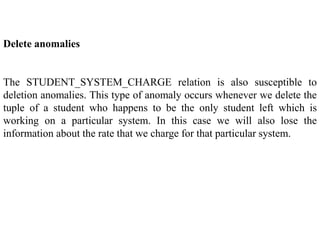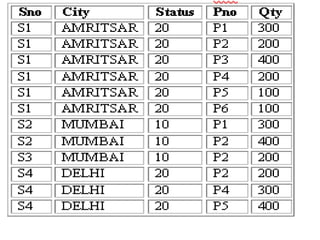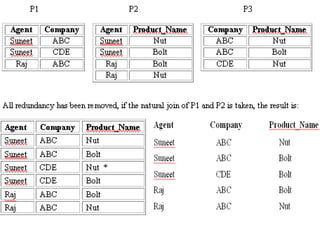Normalization of Data Base
- 2. Objectives of Normalization • To create a formal framework for analyzing relation schemas based on their keys and on the functional dependencies among their attributes. • To obtain powerful relational retrieval algorithms based on a collection of primitive relational operators. • To free relations from undesirable insertion, update and deletion anomalies.
- 3. Objectives of Normalization • To reduce the need for restructuring the relations as new data types are introduced. • To carry out series of tests on individual relation schema so that the relational database can be normalized to some degree. • When a test fails, the relation violating that test must be decomposed into relations that individually meet the normalization tests.
- 5. Functional Dependence (FD) A functional dependency is an association between two attributes of the same relational database table. One of the attributes is called the determinant and the other attribute is called the determined. For each value of the determinant there is associated one and only one value of the determined. If A is the determinant and B is the determined then we say that A functionally determines B and graphically represent this as AB. The symbols AB can also be expressed as B is functionally determined by A.
- 6. Functional Dependence (FD) • The following table illustrates A B: A B 1 1 2 4 3 9 4 16 2 4
- 7. Functional Dependence (FD) • The following table illustrates that A does not functionally determine B: A B 1 1 2 4 3 9 4 16 3 10 Since for A = 3 there is associated more than one value of B. Functional dependency can also be defined as follows: An attribute in a relational model is said to be functionally dependent on another attribute in the table if it can take only one value for a given value of the attribute upon which it is functionally dependent.
- 8. Fully Functional Dependence(FFD) Fully Functional Dependence(FFD) is defined as Attribute Y is FFD on attribute X , if it is FD on X and not FD on any proper subset of X. For example, in relation Supplier, different cities may have the same status.
- 9. Fully Functional Dependence (FFD) Consider SP table: Here, Qty is FD on combination of Sno, Pno. Here, X has two proper subsets Sno and Pno Qty is not FD on Sno, because one Sno can supply more than one quantity. Qty is also not FD on Pno, because one Pno may be supplied many times by different suppliers with different or same quantities. So, Qty is FFD on composite attribute of (Sno, Pno)à Qty.
- 10. First Normal Form • A relation is said to be in First Normal Form (1NF) if and only if every entry of the relation (the intersection of a tuple and a column) has at most a single value. • In other words “a relation is in First Normal Form if and only if all underlying domains contain atomic values or single value only.”
- 12. First Approach: Flattening the table The first approach known as “flattening the table” removes repeating groups by filling in the “missing” entries of each “incomplete row” of the table with copies of their corresponding non-repeating attributes. The following example illustrates this.
- 14. Second Approach: Decomposition of the table The second approach for normalizing a table requires that the table be decomposed into two new tables that will replace the original table. However, before decomposing the original table it is necessary to identify an attribute or a set of its attributes that can be used as table identifiers.
- 15. Rule of decomposition ¨ One of the two tables contains the table identifier of the original table and all the non-repeating attributes. ¨ The other table contains a copy of the table identifier and all the repeating attributes.
- 16. To normalize the STUDENT table we need to replace it by two new tables. The first table COURSE contains the table identifier and the non- repeating groups.These attributes are Course_Code (the table identifier), Course_Name, and Teacher_Name. The second table contains the table identifier and all the repeating groups. Therefore, the attributes of COURSE_STUDENT table are Course_Code, Rollno, Name, System_Used, Hourly_Rate and Total_Hrs.
- 18. Anomalies in 1NF Relations (Considering STUDENT table)
- 19. Second Normal Form Definition A relation R is in second normal form (2NF) if and only if it is in 1NF and every non-key attribute is fully functional dependent on the primary key. A resultant database of first normal form COURSE_CODE does not satisfy above rule, because non-key attributes Name, System_Used and Hourly_Rate are not fully dependent on the primary key (Course_Code, Rollno) because Name, System_Used and Hourly_Rate are functional dependent on Rollno and Rollno is a subset of the primary key so it does not hold the law of fully functional dependence. In order to convert COURSE_CODE database into second normal form following rule is used.
- 22. Data Anomalies in 2NF Relations Relations in 2NF are still subject to data anomalies. For sake of explanation, let us assume that the system on which a student works functionally determines the hourly rate charged from the student. That is, System_Used Hourly_Rate. This fact was not considered in the explanation of the previous normal form but it is not an unrealistic situation.
- 23. Insertion anomalies Insertion anomalies occur in the STUDENT_SYSTEM_CHARGE relation. For example consider a situation where we would like to set in advance the rate to be charged from the students for a particular system. We cannot insert this information until there is a student assigned to that type of system. Notice that the rate that is charged from student for a particular system is independent of whether or not any student uses that system or not. Update anomalies Update anomalies will also occur in the STUDENT_SYSTEM_CHARGE relation because there may be several students which are working on the same type of the system. If the Hourly_Rate for that particular system changes, we need to make sure that the corresponding rate is changed for all students that work on that type of system. Otherwise the database may end up in an inconsistent state.
- 24. Delete anomalies The STUDENT_SYSTEM_CHARGE relation is also susceptible to deletion anomalies. This type of anomaly occurs whenever we delete the tuple of a student who happens to be the only student left which is working on a particular system. In this case we will also lose the information about the rate that we charge for that particular system.
- 26. Third Normal Form A relation R is in Third Normal Form (3NF) if and only if the following conditions are satisfied simultaneously: (1) R is already in 2NF (2) No nonprime attribute is transitively dependent on the key. Another way of expressing the conditions for Third Normal Form is as follows: (1) R is already in 2NF (2) No nonprime attribute functionally determines any other nonprime attribute. These two sets of conditions are equivalent.
- 29. Conversion of STUDENT_SYSTEM_CHARGE (Rollno, Name, System_Used, Hourly_Rate) to Third Normal Form The scheme of the first relation is STUDENT_SYSTEM (Rollno,Name,System_Used). The scheme of the second relation is CHARGES (System_Used,Hourly_Rate).
- 34. For example, consider a relation SSP ( Sno, Sname, Pno, Qty )
- 35. BCNF is simply a stronger definition of 3NF. BCNF makes no explicit reference to first and second normal form as such, nor the concept of full and transitive dependence. BCNF states that A relation R is in Boyce/Codd N/F (BCNF) if and only if every determinant is a candidate key. Here determinant is a simple attribute or composite attribute on which some other attribute is fully functionally dependent. For example Qty is FFD on (Sno, Pno) (Sno, Pno) Qty, here (Sno, Pno) is a composite determinant. Sno Sname Here Sno is simple attribute determinat.
- 36. Similarities between 3NF and BCNF A relation which is in 3NF is always in BCNF. For example, relation COURSE_STUDENT and STUDENT_SYSTEM_CHARGE which are not in 3NF are also not in BCNF. COURSE_STUDENT (Course_Code,Rollno,Name,System_Used,Hourly_Rate,Total_Hours) Here, (Course_Code, Rollno) Total_Hours Rollno Name | System_Used | Hourly_Rate Here, Rollno is a determinant but not candidate key so relation COURSE_STUDENT is not in BCNF. In relation STUDENT_SYSTEM_CHARGE (Rollno,Name,System_Used,Hourly_Rate) Rollno Name | System_Used | Hourly_Rate System_Used Hourly_Rate Here, System_Used is also a determinant but it is not unique, so relation
- 37. COURSE (Course_Code,Course_Name,Teacher_Name) COURSE_ASSIGNED ( Course_Code,Rollno,Total_Hours) STUDENT_SYSTEM (Rollno,Name,System_Used) CHARGE(System_Used,Hourly_Rate) In conclusion, we can say that in these relations which have only single candidate key can be normalized both with 3NF and BCNF without any problem.
- 38. Differences in 3NF and BCNF In order to show the difference between 3NF and BCNF, relations having overlapping of candidate keys are considered in detail. Overlapping of Candidate keys: Two candidate keys overlap if they involve two or more attributes each and have an attribute in common. (Id_no, Item_No) Quantity (Name,Item_No) Quantity Item_NoName NameItem_No
- 40. Decomposition • Id_Name (Id_no, Name) • ID_QTY(Id_no, I tem_No, Quantity)
- 41. Fourth Normal Form (4NF) A relation R is in Fourth Normal Form (4NF) if and only if the following conditions are satisfied simultaneously: (1) R is already in 3NF or BCNF. (2) If it contains no multi-valued dependencies. Multi-Valued Dependency (MVD) MVD is the dependency where one attribute value is potentially a ‘multi- valued fact’ about another. Consider the table
- 43. MVD can be defined informally as follows: MVDs occur when two or more independent multi valued facts about the same attribute occur within the same table. It means that if in a relation R having A, B and C as attributes, B and C are muti-value facts about A, which is represented as AB and AC ,then muti value dependency exist only if B and C are independent of each other. There are two things to note about this definition. Firstly, in order for a table to contain MVD, it must have three or more attributes. Secondly, it is possible to have a table containing two or more attributes which are inter-dependent multi valued facts about another attribute. This does not give rise to an MVD. The attributes giving rise to the multi-valued facts must be independent of each other
- 45. Here in above database following MVDs exists: CourseStudent_name CourseText_book Anomalies of database with MVDs Rule to transform a relation into Fourth Normal Form A relation R having A,B, and C, as attributes can be non loss- decomposed into two projections R1(A,B) and R2(A,C) if and only if the MVD AB|C hold in R.
- 46. CourseStudent_name CourseText_book To put it into 4NF, two separate tables are formed as shown below: COURSE_STUDENT (Course,Student_name) COURSE_BOOK (Course,text_book)
- 48. Fifth Normal Form (5NF) A relation R is in Fifth Normal Form (5NF) if and only if the following conditions are satisfied simultaneously: (1) R is already in 4NF. (2) It cannot be further non-loss decomposed. 5NF is of little practical use to the database designer, but it is of interest from a theoretical point of view and a discussion of it is included here to complete the picture of the further normal forms. In all of the further normal forms discussed so far, no loss decomposition was achieved by the decomposing of a single table into two separate tables. No loss decomposition is possible because of the availability of the join operator as part of the relational model. In considering 5NF, consideration must be given to tables where this non-loss decomposition can only be achieved by decomposition into three or more separate tables.
- 52. But now consider the different case where, if an agent is an agent for a company and that company makes a product, then he always sells that product for the company. Under these circumstances, the ‘agent_company_product’ table as shown below:
- 54. Join Dependence • The rule is referred to as a Join Dependency, because it holds good only if a table can be reconstituted without loss of information from the join of certain specified projections of it. • The notation used for a join dependency on table T is: • *(X,Y,…….Z) • Where X,Y,…Z are projections of T. • Table T is said to satisfy the above join dependency, if it is equal to the join of the projections X, Y,… Z. • Thus, the second example given of the table ‘agent_company_product’ can be said to satisfy the join dependency: • *(P1, P2, P3)
- 55. • 5NF is defined by the statement: • A table T is in fifth normal form if every join dependency in T is a consequence only of the candidate keys of T.
- 56. DENORMALIZATION • Denormalization is the process of attempting to optimize the performance of a database by adding redundant data or by grouping data. In some cases, denormalization helps cover up the inefficiencies inherent in relational database software. • A normalized design will often store different but related pieces of information in separate logical tables (called relations). If these relations are stored physically as separate disk files, completing a database query that draws information from several relations (a join operation) can be slow. If many relations are joined, it may be prohibitively slow.
- 57. • There are two strategies for dealing with this. The preferred method is to keep the logical design normalized, but allow the DBMS to store additional redundant information on disk to optimize query response. In this case it is the DBMS software's responsibility to ensure that any redundant copies are kept consistent. This method is often implemented in SQL as indexed views (MS SQL) or materialized views (Oracle). A view represents information in a format convenient for querying, and the index ensures that queries against the view are optimized.
- 58. • The more usual approach is to denormalize the logical data design. With care this can achieve a similar improvement in query response, but at a cost—it is now the database designer's responsibility to ensure that the denormalized database does not become inconsistent. This is done by creating rules in the database called constraints, that specify how the redundant copies of information must be kept synchronized. It is the increase in logical complexity of the database design and the added complexity of the additional constraints that make this approach hazardous. Some times a denormalized database under heavy write load may actually offer worse performance than its functionally equivalent normalized counterpart.
- 59. • A denormalized data model is not the same as a data model that has not been normalized, and denormalization should only take place after a satisfactory level of normalization has taken place and that any required constraints and/or rules have been created to deal with the inherent anomalies in the design. For example, all the relations are in third normal form and any relations with join and multi-valued dependencies are handled appropriately.
- 60. Uses of Denormalization • Databases intended for Online Transaction Processing (OLTP) are typically more normalized than databases intended for Online Analytical Processing (OLAP). OLTP Applications are characterized by a high volume of small transactions such as updating a sales record at a super market checkout counter. The expectation is that each transaction will leave the database in a consistent state. By contrast, databases intended for OLAP operations are primarily "read mostly" databases. OLAP applications tend to extract historical data that has accumulated over a long period of time. For such databases, redundant or "denormalized" data may facilitate Business Intelligence applications. Specifically, dimensional tables in a star schema often contain denormalized data.
- 61. • Denormalization is also used to improve performance on smaller computers as in computerized cash-registers and mobile devices, since these may use the data for look-up only (e.g. price lookups). • Denormalization may also be used when no RDBMS exists for a platform (such as Palm), or no changes are to be made to the data and a swift response is crucial.

